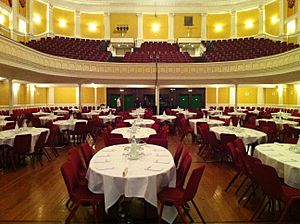Wellington Town Hall facts for kids
Quick facts for kids Wellington Town Hall |
|
|---|---|
|
Te Whare Whakarauika (Māori)
|
|

The Town Hall from Civic Square
|
|
| General information | |
| Type | Town hall, concert hall |
| Architectural style | Neo-Renaissance |
| Location | Corner of Wakefield Street and Civic Square, Wellington |
| Coordinates | 41°17′21″S 174°46′38″E / 41.2893°S 174.7773°E |
| Current tenants | Wellington City Council |
| Construction started | 1901 |
| Completed | 1904 |
| Owner | Wellington City |
| Design and construction | |
| Architect | Joshua Charlesworth |
| Main contractor | Paterson, Martin and Hunter |
| Designated: | 11 December 2003 |
| Reference #: | 3275 |
The Wellington Town Hall (Māori: Te Whare Whakarauika) is a concert hall and part of the municipal complex in Wellington, New Zealand, which opened in December 1904. It has been closed to the public since the 2013 Seddon earthquake, and it is currently undergoing extensive strengthening work.
History
The foundation stone for the building was laid in 1901 and construction began the following year. It was officially opened on 7 December 1904.
The Town Hall was originally fronted (on the Cuba Street side) with a Roman styled portico and a 150-foot clock tower. A clock was not installed in the tower until 1922, when John Blundell, owner of The Evening Post newspaper, donated one. In 1934 the tower was removed as a precaution following the 1931 Hawke's Bay earthquake, and the main portico, pediment, balustrade, parapet and bold cornice were also removed. The building was earthquake strengthened in 1943 following an earthquake the previous year. During the strengthening the Corinthian capitals on the exterior were replaced with Tuscan detailing.
The Town Hall may have been a low maintenance priority of councils over the years. By 1973 during a concert (Kenny Rogers and The First Edition) their sound levels caused dust to begin to drift down over the stage. When their music hit a crescendo during the chorus of one piece (may have been Something's Burning), the stage ceiling collapsed on them, dropping pigeon bodies, empty and dead eggs, nesting material and plaster rubble and dust all over the stage and the band's equipment. The concert did continue, with black-dressed stage hands creeping around the stage sweeping up detritus, removing carcasses, and dusting the amplifiers, speaker cases, keyboards, and anything else covered with plaster dust. Shortly after, Wellington citizens began to call for an improved concert venue.
In 1980 the Michael Fowler Centre was built immediately in front of the Town Hall's main entrance in anticipation of the older building's demolition. However the New Zealand Historic Places Trust (since renamed to Heritage New Zealand) persuaded the City Council to retain the Town Hall. In 1989 plans were unveiled to create Civic Square between the town hall and the old city library. As part of this, the Town Hall underwent full refurbishment in 1991–1992. During this process the concert chamber was demolished and replaced with reception rooms.
The main auditorium has been rated one of the best in the world for acoustic quality. It has hosted numerous live performances (including The Beatles & The Rolling Stones) as well as fashion shows, debutante balls, political rallies, degree conferrals and at least one episcopal ordination, that of Cardinal John Dew in 1995.
Although the council offices have spread beyond the Town Hall since 1904, until it was closed for earthquake strengthening, the building still housed the offices of the Mayor and Wellington City Council members.
Earthquake strengthening
In 2014, quake strengthening was put on hold by Wellington City Council after cost projections increased from $43 million to $60 million due to unforeseen technical issues. In March 2017 Wellington City Council announced its intention to bring the Town Hall up to 100% of the New Zealand building regulations at a cost of $85 million, with construction to begin in 2018 and an aim to re-open in 2021. As restoration work began further complexities were uncovered, and increasing costs meant that in February 2019 the council extended the budget to $112 million, with an undisclosed amount of additional contingency. The extra work required will include seismic base isolation to better secure the long term future of the building, while delaying the opening by a further two years to 2023.
See also
 In Spanish: Palacio consistorial de Wellington para niños
In Spanish: Palacio consistorial de Wellington para niños




